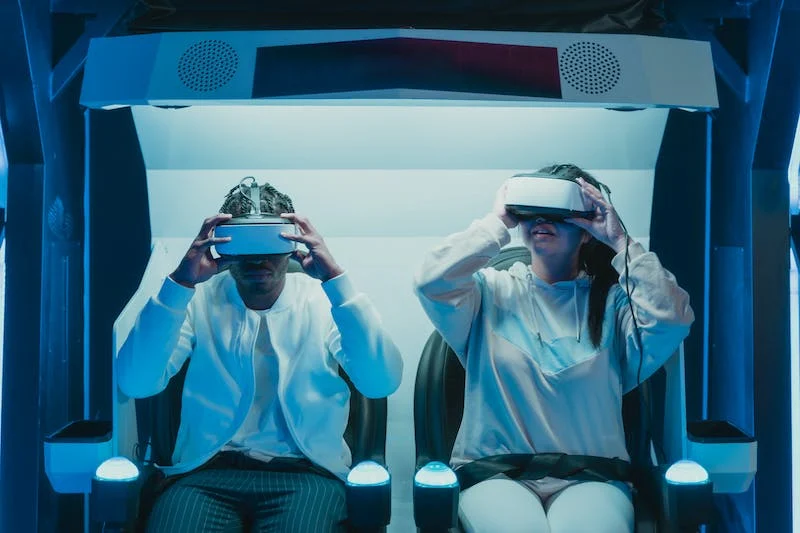Contents
- The End of the Gimmick Era
- The Rise of Spatial Gaming
- Industry Momentum: A Multi-Billion Dollar Reality
- Hardware Evolution: Comfort Meets Performance
- Immersive Content: From Games to Worlds
- The Social Layer: Shared Presence and Digital Identity
- From Entertainment to Everyday Use
- Challenges and Growing Pains
- The Road Ahead: The Convergence of Realities
- The Bottom Line: Immersion Becomes Reality
Meta Description:
Virtual and augmented reality are no longer gimmicks — they’re maturing into powerful platforms for immersive, spatial, and hybrid gaming experiences that merge the physical and digital worlds.
Technology & Gaming Correspondent
Once dismissed as futuristic novelties, virtual reality (VR) and augmented reality (AR) are stepping into their prime. The immersive technology revolution is no longer about early adopters experimenting with clunky headsets and short tech demos — it’s about mainstream gamers, developers, and hardware companies reimagining what “play” really means.
According to Scope Gaming Magazine’s 2025 Global Gaming Outlook, the immersive gaming market has entered what analysts call the “maturity phase.” Hardware is becoming sleeker, content richer, and cross-platform integration far more seamless. From the living room to the factory floor, from esports arenas to classrooms, VR and AR — together often referred to as mixed reality (MR) or spatial computing — are blurring the lines between the digital and physical worlds.
“We’ve moved beyond novelty,” says Marcus Kim, senior analyst at Scope Gaming Magazine. “Immersive gaming is now a viable, scalable industry — one that’s reshaping entertainment from the ground up.”
The End of the Gimmick Era
A decade ago, VR gaming was synonymous with bulky headsets, tangled cables, and motion sickness. AR, meanwhile, was largely confined to smartphone experiments like Pokémon GO (2016), which hinted at potential but never quite delivered a holistic, immersive experience.
But in 2025, things look very different. Advances in optics, AI-based spatial tracking, and lightweight form factors have made VR and AR not only more comfortable but also more convincing. Devices like Apple’s Vision Pro, Meta Quest 3, and Sony’s PSVR2 have pushed the technology into the mainstream by combining powerful sensors with intuitive user interfaces.
Latency — once the bane of VR immersion — has dropped to imperceptible levels thanks to faster processors and 5G/6G connectivity. Meanwhile, mixed reality devices can now seamlessly map the real world in real time, overlaying interactive holograms onto physical surroundings with stunning precision.
“It’s not about escaping reality anymore,” says Kim. “It’s about enhancing it.”
The Rise of Spatial Gaming
The next evolution of immersive tech is spatial gaming — experiences that don’t just exist in a headset but actively interact with the player’s physical environment. Using spatial mapping, depth sensors, and AI, games can now recognize walls, furniture, and even other players in the room.
Imagine battling alien invaders crawling up your actual walls or collaborating with friends around a virtual tabletop in your living room. Titles like Meta’s First Encounters, Apple’s Spatial Battle, and Niantic’s Peridot are pioneering this hybrid approach.
“Spatial gaming bridges the gap between virtual and real,” explains Dr. Lina Rojas, head of AR research at Niantic Labs. “It transforms the world around you into your playground.”
The trend extends beyond entertainment. Educational, health, and industrial simulations are now leveraging spatial tech to train users in realistic, interactive environments. Surgeons practice operations in holographic theaters, engineers assemble digital twins of machinery, and athletes use AR overlays to refine performance.
Industry Momentum: A Multi-Billion Dollar Reality
The numbers tell the story. According to Scope Gaming Magazine’s 2025 report, the global VR and AR gaming market surpassed $42 billion this year — up from $31 billion in 2023. Analysts project the sector could exceed $80 billion by 2028, driven by both consumer demand and enterprise adoption.
Hardware manufacturers are seeing major growth as well. Meta has shipped over 20 million Quest headsets, Apple’s Vision Pro is selling faster than analysts predicted, and Sony’s PSVR2 has revitalized console-based VR with exclusive titles like Horizon: Call of the Mountain and Resident Evil Village VR.
But the real shift isn’t just hardware — it’s ecosystem. Cloud gaming integration now allows VR experiences to stream directly from servers, removing the need for expensive PCs. AI-generated environments adapt in real time, making every gameplay session unique.
“We’re entering the golden age of immersive content,” says Rojas. “Developers have the tools, the platforms, and the audience to make VR and AR truly mainstream.”
Hardware Evolution: Comfort Meets Performance
Comfort and usability have been the biggest hurdles to mainstream VR adoption — but those are being addressed head-on. The latest generation of devices combines lightweight design with high-performance capabilities.
Apple Vision Pro, for example, introduced micro-OLED displays capable of 23 million pixels per eye, while Meta Quest 3 offers full-color passthrough, allowing users to switch seamlessly between VR and mixed reality modes.
Sony’s PSVR2 features eye tracking, foveated rendering, and haptic feedback, creating an unparalleled sense of immersion. These innovations reduce fatigue, improve realism, and make extended sessions far more enjoyable.
At the same time, open standards like OpenXR are helping unify development across platforms, allowing games and applications to run across multiple devices — something that was previously impossible in the fragmented VR landscape.
“Cross-compatibility is a game-changer,” notes Kim. “It means developers can focus on experiences, not hardware.”
Immersive Content: From Games to Worlds
The evolution of hardware has unlocked new creative possibilities for developers. VR and AR titles are no longer tech demos or short experiments; they’re expansive worlds that rival traditional games in scope and depth.
Massive multiplayer VR games like Zenith: The Last City and Population: One have cultivated dedicated communities, while narrative-driven experiences such as Lone Echo II and Asgard’s Wrath 2 push storytelling into new emotional territory.
On the AR side, titles like The Walking Dead: Our World and Peridot use geolocation and computer vision to create persistent, real-world experiences. Developers are also experimenting with mixed-reality esports, where players compete in arenas blending physical movement with digital environments projected in real space.
“Mixed reality is redefining what it means to be present,” says Rojas. “You’re not just playing a game — you’re inside it.”
One of the most exciting aspects of immersive tech is its social potential. Platforms like Meta Horizon Worlds, VRChat, and Rec Room have evolved into vibrant virtual communities where millions of players socialize, create, and attend events together.
These platforms are merging gaming, social networking, and creativity into one ecosystem. Users design avatars, build custom environments, and even host concerts, talk shows, or conferences in digital spaces.
The line between game and social network is disappearing. For younger generations, VR hangouts are becoming as natural as texting or video calls. And as AR glasses and mixed reality headsets become more common, these interactions are spilling into the physical world — creating hybrid spaces where virtual objects and real people coexist.
“The future of gaming is social, spatial, and persistent,” says Kim. “It’s not about screens anymore — it’s about presence.”
From Entertainment to Everyday Use
The adoption of immersive technology is no longer confined to gamers. Businesses, educators, and healthcare providers are all embracing VR and AR as tools for visualization, collaboration, and simulation.
In education, VR field trips and 3D science labs allow students to explore complex concepts hands-on. In healthcare, AR is used for surgery planning and physical rehabilitation, offering more intuitive interfaces than traditional screens. In manufacturing and logistics, mixed reality is being used for digital twin simulations — allowing workers to interact with holographic models of real-world systems before touching a single physical part.
This crossover between industries is helping fuel gaming innovation, too. The same spatial tracking technologies used for industrial AR are being repurposed for more responsive game worlds and motion systems.
“Immersive tech isn’t siloed anymore,” says Rojas. “It’s one ecosystem — and gaming is at its center.”
Challenges and Growing Pains
Despite its progress, the immersive tech industry still faces hurdles. Hardware cost remains a major barrier; premium headsets like the Apple Vision Pro retail for over $3,000, putting them out of reach for most gamers. Even affordable options like Meta Quest 3, priced around $500, can be a stretch in emerging markets.
Motion sickness and eye strain continue to affect some users, though advancements in display refresh rates and motion prediction have reduced these issues significantly. Battery life is another limitation, especially for standalone headsets that prioritize portability.
Content diversity is also crucial. Many users buy a headset for one or two blockbuster experiences and then struggle to find ongoing reasons to use it. Developers are now focusing on live-service models and user-generated content to keep players engaged.
“Every new medium faces this phase,” says Kim. “The question isn’t whether VR/AR will succeed — it’s how fast it will mature.”
The Road Ahead: The Convergence of Realities
As VR and AR technologies continue to merge, the concept of mixed reality — or spatial computing — is becoming the unifying framework for immersive interaction.
By 2030, experts predict that traditional screens could become optional for many forms of entertainment. Lightweight glasses, powered by AI and cloud computing, will project interactive digital overlays onto the real world. Gaming will no longer be confined to a monitor or TV — it will exist in every room, street, and park.
Developers are already experimenting with holographic multiplayer, persistent digital objects, and AI-driven adaptive storytelling that blurs fiction and reality. Imagine a mystery game where clues appear in your real-world kitchen, or an AR RPG where your neighborhood becomes the game board.
“Spatial computing is the next internet,” says Rojas. “It’s not about looking at data — it’s about living inside it.”
The Bottom Line: Immersion Becomes Reality
The immersive and mixed reality revolution has reached its tipping point. What began as experimental tech has matured into one of the most exciting frontiers in gaming and digital interaction. With every generation of headsets, with every software breakthrough, the virtual and physical worlds draw closer together.
As prices drop and adoption rises, immersive gaming is poised to become as ubiquitous as mobile gaming once did. The question is no longer if VR and AR will transform gaming — but how profoundly they will transform how we live, learn, and connect.
“We’re not escaping reality anymore,” Kim concludes. “We’re expanding it — one headset at a time.”
🔗 Sources & Further Reading
See related coverage: The Rise of Cloud Gaming: How Streaming and Device Independence Are Redefining the Future of Play



